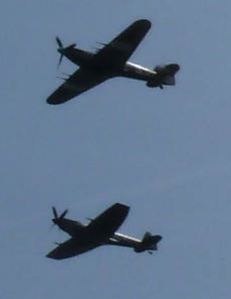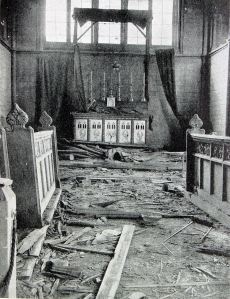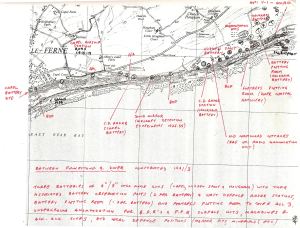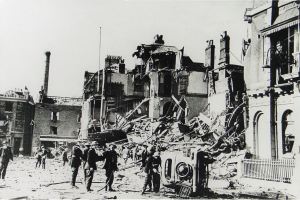On 3 September 1939 Britain declared war on Germany following their invasion of Poland. Hitler, from the outset had employed ‘blitzkrieg’ tactics and overrun five other countries: Denmark, Norway, Holland, Belgium and France. In June 1940 Britain’s armies had been driven back with the only escaped from Continental soil was by the massive Dunkirk evacuation. At the time Hitler boasted that the war would be over by the end of 1940 and he would enter London in triumph before Christmas.
The collapse of all Continental resistance gave the Nazi’s complete command of Europe’s western seaboard from Narvik in the north to the Spanish frontier in the south. This provided air and naval bases that made Britain within easy range of their guns. However, invasion could only be attempted after the British fleet had been crippled or destroyed and the airforce driven from the skies.
Between the 10 July and 31 October 1940, a prolonged aerial conflict took place for the control of the skies above the Channel and South Eastern England. This was between the Luftwaffe (the German air force) and the Royal Air Force. This conflict became known as the Battle of Britain.
To achieve his objective Hitler relied upon his airforce, the Luftwaffe, and during June, July and the first week in August an offensive was mounted to gain supremacy of the sea and skies. This was in preparation for 10 August, Adler Tag (Eagle Day), the first part of a three phased planned invasion code named Operation Sea Lion.

Fighter Command Groups and Sector Boundaries, Airfields & Squadrons 18.08.1940. BofB Memorial, Capel
At the time there were eight military airfields in Kent, Biggin Hill, Manston, Hawkinge, Gravesend, Eastchurch, Detling, Lympne and West Malling. The first four were to play a major role in the Battle; Coastal Command used Eastchurch and Detling; Lympne was used in emergencies and Manston and Hawkinge, due to their proximity with the coast, were used for damaged aircraft and wounded pilots as well as forward bases for other airfields. West Malling did not come operational until later that year.
In overall charge was Air Chief Marshal Sir Hugh Dowding, Commander in Chief, Fighter Command, from 1936 to 1940. Fighter Command was divided into four Fighter Groups, Nos. 10,11,12 and 13, with each group subdivided into further sectors. Group 11 had 6 sectors, 12 = 5 sectors, 13 = 4 sectors and 10 = 2 sectors.
Each sector had an operations room plus emergency standby and satellite airfields. Information was collected by the ‘Y’ service, which monitored German wireless messages along with Chain Home radar stations, such as the one at Swingate, that tracked aircraft movements. All of which was confirmed, or otherwise, by the Observer Corps. In 1941 they were given the accolade of Royal. They supplied visual reports by sightings.
Pete Marshall, whom I met at the Battle of Britain Memorial, Capel, near Dover, tells me that a sector controller looked after up to a maximum of 6 squadrons in his particular sector. Incoming raids, marked as hostiles, were tracked by RDF (radar) as they cross the Channel and then by the OC. In the operations room were detailed maps and wooden blocks, called plots, marked with the raid number and estimated number of aircraft were used to indicate the position of the hostile craft.

Uxbridge Group 11 Operations room showing the plot, the wooden blocks with the raid and estimated number and the coloured arrows – thanks to Pete Marshall
As reports came in coloured arrows were used and placed on the board with their colour corresponding to the coloured sector of a clock, in which the minute hand was the time of the report. If the minute hand is in blue, then a blue arrow was used for information less than 5 minutes old, yellow up to 10 minutes old and red up to 15 minutes. If the minute hand were in the red sector, then blue arrows would show the information to be up to 10 minutes old, as new reports of less than 5 minutes would be shown with red arrows.
The colours and times were all dependent on where the minute hand was at any particular moment. If the minute hand had moved to the next sector of the same coloured sector without receiving an update, the arrows were removed from the plot. A plot with no arrows indicates a position over 15 minutes old and therefore unreliable. It is said that this is where the expression ‘losing the plot’ comes from.
The Battle of Britain began on 10 July, with hundreds of sorties by Hurricanes and Spitfires against the Luftwaffe’s Messerschmitt and Heinkel fighters. That day Dover ambulance driver, George Knight, received a bullet wound to his leg while watching the dogfights overhead. Four days before, 10 small 100lb bombs were dropped on Dover; they did little damage but aroused a great deal of curiosity. Then the Germans launched daylight raids against ports and airfields.
One of the most determined attacks was on British shipping in the Strait of Dover on 14 July, when about forty dive-bombers escorted by fighters, took part. Pilot Officer Mudie’s Hurricane was hit; he baled out, but died of his injuries the next day. On 25 July, enemy dive-bombers attacked merchant ships and destroyers causing 122 naval casualties that were treated at Dover’s Buckland Hospital – then known as the Casualty Hospital.
The 27 July saw the biggest air fight thus far off Britain’s coast when 80 German planes attempted a surprise raid on shipping in the harbour. HMS Codrington, a destroyer was hit and never went to sea again. Moored nearby was HMS Sandhurst that was set alight by incendiary bullets but survived. Dover firemen went with her to the Thames, still pumping out her holds. Captain Fred Hopgood, one of the Harbour Board tug masters (later Harbour Master for eleven years), along with Dover’s police/firemen Ernest Herbert Harmer, Cyril William Arthur Brown and Alexander Edmund Campbell were awarded the George Medal for their part in saving several ships that day and the following two days.
In the meantime, preparations were being made to resist the invasion. Along the coast barbed wire and guns commanded every likely line of approach. Troops trained constantly in the art of mechanised warfare and carried out extensive manoeuvres in readiness for the day when the enemy should come. Britain’s civilian army, the Home Guard, watched all approaches to cities and towns, built pillboxes, dug trenches and prepared to take on the enemy at close quarters if necessary. Farmers, aided by Women’s Land Army ‘land girls’, worked to keep the nation fed. Around Dover and the harbour, batteries were manned 24/7 and local railway lines were utilised as mobile batteries. Behind the cliffs of St Margaret’s Bay the first big artillery pieces were installed.
At Drellingore (near Bushy Ruff) in the Alkham Valley, a special unit of local civilian volunteers under the command of Lt. Cecil Lines, and consisting of George Marsh, Samuel Osborne, Thomas Holmans, Charles Fayers and Denis Dewars prepared to carry out subversive actions if the invasion came. The platoon’s quarters was a bunker hewn out of the hillside in a small coppice and was full of a variety of armaments. Each man was personally issued with a .38 Smith & Wesson revolver, a Fairbairn Commando knife and a brass knuckleduster. They had been taught to kill silently.
On 8 August Germany decided that the time had come to launch the carefully prepared three phased, Operation Sea Lion – the invasion of Britain. On that day massed formations of dive-bombers, escorted with powerful fighters attacked Channel convoys and coastal towns, including Dover. The Few, as the RAF pilots involved were later called, responded, but not without casualties. The Spitfire, which 21 years old Sergeant (Pilot) David Kirton, was flying that day, burnt out and crashed. He is buried in St James’ cemetery. There is a seat dedicated to both David and his brother Jim, a squadron leader, killed on 27 January 1944, on Marine Parade.
The first shells, from German long-range guns based in France, were fired onto British soil on 12 August. Four homes were demolished in Noah’s Ark Road killing two and seriously injuring three. Helen Barker and Alfred Reid were killed in St Radigunds Road; distressingly the ambulance driver who went to the incident was Helen’s husband.
Although the long-range guns were not taken out, along the Continental Channel coast bomber planes of the Bomber and Coastal Commands night after night dropped their loads. At the same time long rang bombers flew over Germany bombing railways, roads, munitions factories, oil plants and canals, in an effort to hamper communications and slow down the German war effort.
Together, this showed the Germans that British fighter strength was greater and more formidable than had been anticipated. Therefore, together with the attacks on shipping and coastal towns, large forces were sent to attack the airfields in south and southeast England. The tactics usually involved bombing coastal objectives, in an attempt to draw off British fighters, while making the main assault on the real objective, whether airfield or port, about half an hour later.
On 14 August some 200 aircraft, both British and German, met head-on over Dover and a furious battle ensued. Over the next four days the people of Dover witnessed similar aerial battles at the same time being bombarded with shells from the long-ranged guns in France. In one-day Military authorities estimated that over thirty shells hit the town, resulting in deaths, injuries and major destruction of property.
In the ten days 8-18 August – the first phase of Operation Sea Lion – the Germans lost 697 aircraft against a British loss of 153, and sixty of those the pilots were safe. It is believed that a greater proportion of British pilots would have been saved had the fighting not taken place over the sea.
The second phase of Operation Sea Lion did not begin until 24 August but Britain did not let up and reprisals were swift. On 19 August, following an attack on German ships in the Channel, a bomb was dropped on an Army-v-Navy football match, behind the Castle, killing all the players and some of the spectators. On the evening of 22 August German guns bombarded Dover for an hour badly damaging St Barnabas Church – it was finally demolished in 1954. That day saw the first shell fired from England on France.
The second phase of Operation Sea Lion lasted until 5 September, during which time the enemy made inland airfields their main objective. Altogether there were thirty-five main attacks and the method of attack changed, the numbers of bombers were reduced but the fighter escorts almost doubled. Meanwhile, the British bomber forces kept up their counter attacks over which Hitler threatened dreadful reprisals in a speech of 4 September. He described them as, ‘the nuisance of nightly and planless bomb throwing.‘ The following night the British bombed the industrial areas of Berlin. Altogether, phase two cost the British 219 machines but it also cost the Germans 562 and forced them to change their tactics.
The third phase began on Saturday 7 September – the mass attacks on London. The Germans approached in waves; each composed of formations of between twenty and forty bombers escorted by an equal number of fighters. In all 350 machines crossed the coast, and were quickly engaged by British fighters. However, many succeeded in breaking through but as night fell clouds of smoke over London’s docklands assumed a reddish tinge and throughout that night the enemy dropped high explosive bombs into the heart of the fires. The first great London raid the casualties amounted to 306 killed and 1,337 wounded, while the enemy lost 103 aircraft. Despite these losses the Luftwaffe continued with daylight attacks on the capital.
At the same time as London was blitzed, Dover continued to be pounded. In the town flour mills, which had been commandeered by the government at the outbreak of war as part of the centralising of food, were working full tilt. On Monday 9 September Chitty’s Mill, on Charlton Green was hit by a shell that brought down a wall at the rear of the nearby pub, Admiral Harvey, in Bridge Street. Frank Rogers, the licensee, and his wife were both injured and taken to hospital. Frank died of his injuries the following day.
On 11 September the town was not only shelled and bombed but also attacked by fighters. The west wing of the five storeys Grand Hotel was badly damaged killing one journalist and naval officer Robert Harvey (19) of Hillside Road, Dover. One of the journalists who escaped telephoned his story to the Chicago Tribune the following day. The town’s casualties that day were 16 dead, 23 seriously injured and 39 taken to hospital. Thirty aircraft actually succeeded in reaching London and unloaded their bombs but altogether ninety planes were shot down.
Sunday 15 September was the climax and is now annually celebrated as Battle of Britain Day. 500 German aircraft, 250 in the morning and 250 in the afternoon, made their most determined assault on London. Hurricanes and Spitfires heavily engaged them over the Channel, but again many succeeded in penetrating the defences by sheer weight of numbers. Bombs were dropped on Dover and shells ripped through the town killing and injuring as well as causing devastation. However, 185 of the enemy’s machines were destroyed that day, in actions that were described by Winston Churchill, the Prime Minister as ‘the most brilliant and fruitful of any fought upon a large scale up to date by fighters of the Royal Air Force.’ In Germany, Operation Sea Lion was postponed indefinitely on 17 September.
Despite this crushing reverse German bombers continued their daylight attacks on the London until 5 October. During this period three major assaults were made, 27 September, 30 September and 5 October leading to a German loss of 205 planes. It had become apparent to the German High Command that relatively few bombers actually reached London for as soon as they started to cross the Channel they were met by the force of British fighters and ground artillery.
Thus, the Germans opted for a tip-and-run strategy using only fighters and fighter-bombers, mainly Messerschmitt 109s and 110s. Whenever they met a British fighter they jettisoned (tipped) their bombs and made off (run) as fast as they could. One such attack, on 7 October, wrecked St James’ Parish Hall, St James’ School, the Golden Cross pub, a shop and several private houses in the area. William Ashdown and Benjamin Botten had been repairing the road in St James’ Street and died of their injuries. The following day saw more lives lost in Dover to these attacks.
The Battle of Britain officially ended on 31 October by which time over 50 civilians as well as many Service personnel had lost their lives in the town. Another 200 people had been injured. There were 2,927 men actively involved in defending Britain’s air space. Between 8 August and 31 October they destroyed 2,375 enemy planes with ‘Old Pharosian’ (attended Dover County Boys School – now Boys’ Grammar), Eric Simcox Mars, born in Dover on 9 July 1920, claiming the greatest number of enemy aircraft hits during the Battle.
However, 544 of The Few lost their lives and 358 were wounded. A further 791 were killed in action or died during the course of duty before the war ended, including Eric Simcox Mars in 1941. The Prime Minister, Winston Churchill, expressed the feeling of the nation when he said: ‘The gratitude of every home in our island, in our Empire, and indeed throughout the world, except in the abodes of the guilty, goes out to the British airmen who, undaunted by odds, unwearied in their constant challenge and mortal danger, are turning the tide of the world by their prowess and by their devotion. Never in the field of human conflict was so much owed by so many to so few.’
One face, more than any other, epitomised ‘the Few’, during that summer, it was of Pilot Officer Keith Gillman, who was used by the Air Ministry in their advertising campaign. Keith came from River and also an Old Pharosian. The caption under his photograph – which cannot be reproduced due to copyright – in the Picture Post read, ‘RAF Will Decided our Fate. This smiling young airman and his fellow pilots, whose superiority over the enemy in proportion to their numbers has become significant in the recent campaign. Wherever they have appeared they have easily driven of the enemy dive bombers.’ Pilot Officer Gillman was the first pilot from his squadron to be lost in the Battle of Britain; he was 19 and died on 25 August 1940.
The Battle of Britain Memorial, Capel-le-Ferne just outside Dover, was opened by the Queen Mother, Lord Warden of the Cinque Ports, in 1993 and dedicated to the 69 squadrons who took part in the epic battle in 1940.
- Published:
- Dover Mercury: 15, 22, 29 July and 5 August 2010
- Battle of Britain Memorial, Capel: www.Battleofbritainmemorial.org















